
Advocacy
Chemung Valley Audubon Society continues to advocate for public policy decisions that allow us to continue our important conservation work. We have always been a respected voice when it comes to natural resource issues in our area, and we are able and willing to work with a diverse network of stakeholders to address issues that affect our environment. Here are the issues we are working on now:
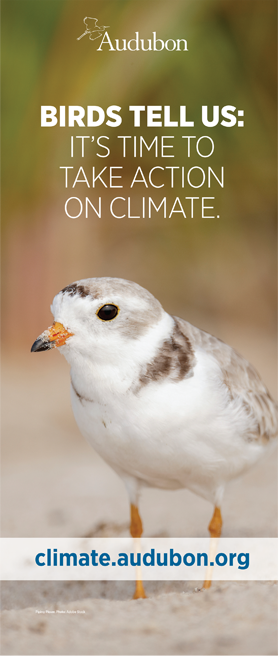
Audubon's New Climate Report
Birds are telling us it's time to take action on climate change.
Over the last five years, Audubon has used the latest climate models and more than 140 million bird records—including data collected from bird lovers like you—to assemble Survival by Degrees: 389 Bird Species on the Brink, a new, ground-breaking report forecasting the survival of North American birds through the end of the century in extraordinary detail. The most detailed look at the impact of climate change on birds using the latest climate models and bird data available, the report includes a first-of-its-kind zip code-based climate tool: Audubon’s Birds and Climate Visualizer, which shows you how climate change will impact local birds and your community—and ways you can help.
Our science shows that 65% of North American bird species are at risk of extinction from climate change. Even common birds like the American Robin, Northern Flicker, and even our European Starling will experience declining populations and radically different ranges in the near future. You can read the state-chosen vulnerable birds list right here, and read about New York's declining bird populations here.
But as the threat of climate change grows, so does Chemung Valley Audubon Society’s work.
This report not only illustrates how our warming planet will impact the birds we all love but also shows us that if we act, there is still time to create a brighter future for birds and people. And we already have a lot of the tools we need to reduce the effects of global warming.
Read the report to learn what birds have been telling us for years: it is time to act.
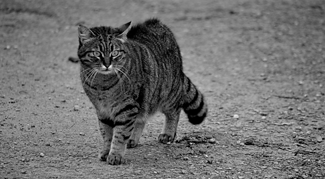
Cats Indoors
Feral and free roaming domestic cats pose a significant danger to birds and other wildlife but many people are unaware of this fact. It is estimated by many conservation groups in the United States and around the world, including the National Audubon Society, that domestic cats kill a lot of birds in the United States every year.
Cats are popular pets. Americans own 90 million cats, and it is estimated that there are tens of millions living in the United States. Cats have been named among the Top 100 Worst Invasive Species in the World; they are not a natural part of the North American Ecosystem. The domestication of the cat took place 9,000 years ago from the Near Eastern Wildcat. Since then, humans have brought domestic cats to most parts of the planet.
Cats hunt and consume most types of small and medium size animals, including birds, mammals, reptiles and insects. Since they are such skilled hunters, those of us who love birds need to do our part to help reduce the predation of wildlife and birds by feral and domestic outdoor cats.
Here is what you can do to help:
- If you own a cat, keep it indoors and encourage other cat owners to do the same. This is as much for the well-being and health of your cat as it is for wildlife. Many cats that are allowed to roam outside encounter feral cats and can catch diseases, or can be attacked and seriously hurt or killed. Your pet cat can also encounter other dangers, including cars, dogs, and people. Keeping your cat inside will ensure its safety and well-being.
- Use a collar and tag or a microchip to ID your cats in case they get outside and are lost.
- Do not feed unknown cats. Feeding cats will only encourage them to establish a presence and lead to an increase in their numbers. Instead, buy a Havahart or Tru-Catch humane cat trap, bait it with cat food, and take the cat to your local shelter. There, the cat will receive the care it needs and will have a chance to be adopted or reunited with its owner.
- Always spay and neuter your cats!
Cats are not responsible for the damage that they cause to the ecosystem by killing defenseless birds and other wildlife; humans are. Collectively, we need to do a better job protecting birds and wildlife from cat predation. Keeping your cats indoors, getting them spayed or neutered, and not feeding stray cats are the best way we can keep birds safe. Thank you for helping us protect our wildlife and keeping our cats safe and healthy!
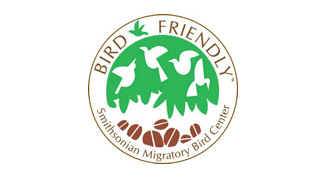
Bird Friendly Coffee
Supermarket shelves are filled with coffee that claims to be environmentally friendly, but only coffee with the Bird Friendly Seal helps save vital habitat for migratory birds.
What makes Bird Friendly Coffee better? The Bird Friendly Seal from the Smithsonian Migratory Bird Center--this seal guarantees that all Bird Friendly Coffee is organic, and guarantees a variety of shade trees throughout the coffee plantation. The Smithsonian Migratory Bird Center standards are strict, making sure the "agroforests" are the right habitat for migratory birds. Producers of Bird Friendly Coffee must be recertified every three years to make sure they are meeting all of the requirements to be given the label of Bird Friendly.
All bird lovers would agree protecting vital habitats is critical for our planet's bird species, such as the Baltimore Oriole, Rose Breasted Grosbeak, and Chemung Valley Audubon's own "mascot," the Scarlet Tanager.
Chemung Valley Audubon would like to encourage all of our members and the public to buy and drink Bird Friendly Coffee. It is very easy to do because Birds and Beans brand Bird Friendly Coffee is sold locally at the Wild Birds Unlimited stores right in Big Flats and Ithaca, New York.
Please make the switch from conventional coffee to coffee with a conscience. Switch to Birds and Beans brand Bird Friendly Coffee today.
Wind Power
Climate change is real. The effects of climate change are happening now and continue to get worse. Audubon New York and the National Audubon Society are in agreement with the research and scientists that climate change has disrupted half of the world's species' breeding, distribution, abundance, and survival rates. One in six of the world's species are facing extinction because of climate change.
Since climate change is caused in part by humans' burning of stored carbon to produce energy, collectively we need to use our voice to encourage industry, state, and national government to help develop and use alternative energy sources that will minimize the effects of climate change.
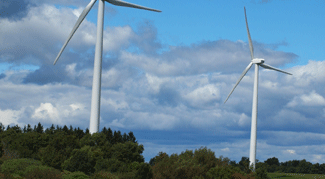
Properly-sited wind power is an energy source that can greatly reduce our dependence on carbon-based energy that contributes to climate change. Chemung Valley Audubon Society supports Audubon New York's guidelines for the development and use of wind power.
- The proper siting and operation of wind farms and equipment, including the avoidance of major migratory bird pathways, and consulting the best science to minimize death and damage to birds and wildlife
- Development of new technology that minimizes harm and death to birds and wildlife.
- Mitigation of habitat and wildlife impacts with conservation.
- Strong enforcement of laws that protect wildlife: The Endangered Species Act, The Migratory Bird Treaty Act, and The Bald and Golden Eagle Protection Act.
Wind developers and permitting agencies should consult with wildlife experts, including National Audubon Society and Audubon state and local chapters to help inform any windmill siting decisions so that together we can work to help reduce harm and death to wildlife and birds. Chemung Valley Audubon Society encourages its members to contact their local and state representatives to ask them to make sure wildlife and birds are considered when all energy decisions are being made including Wind Power. Our collective voice can make a difference.
F.L.A.P.

The Fatal Light Awareness Program (FLAP) was launched in 1991 in Toronto, the first city in the world to address the problem of light pollution in urban cities and the effect it has on birds. Many birds migrate after the sun sets using starlight and moonlight as a guide, but as our society has advanced, so has our penchant for evening lights. Bird collisions with windows happen year-round and at any type of building--commercial or residential. It is estimated that at least 365 million and as many as 988 million birds die annually across the United States by colliding with windows and other structures. These deaths from collisions with windows and other man-made structures are the second-largest man-made threat to birds after habitat loss.
When confronted with a pane of glass, most bird species are vulnerable because they don't perceive the glass as a barrier. Glass is transparent and reflective. Birds are drawn by the reflection of sky or nearby trees in the panes. When tricked by this illusion, birds fly right into windows and often fatally knock themselves out. Glass is killing the healthiest and weakest birds alike, and to make matters worse, many of the victims are migrating songbirds that are already in decline due to habitat loss and other factors. Some good news to report is that many cities are participating in FLAP. Cities that take part in FLAP turn off bright exterior lighting and unnecessary interior lighting of high rise buildings between 11:00 p.m. and dawn during the spring and fall migration season. Since many bird species migrate at night, this action helps save birds.
Audubon and its partner organizations organize Lights Out campaigns to encourage everybody to turn off their lights at night and save the birds. These programs don't just benefit the birds! Energy conservation is a daily struggle for all of us, and the Lights Out program helps to promote responsible energy usage. Every year, more cities participate in FLAP. In Chicago, every building taller than 60 stories turns off its lights in the evening so that migrating birds are able to fly more safely, and property owners save on electricity costs. In New York, over 90 buildings, including the Rockefeller, the Chrysler Building, and Time Warner Center, keep evening lighting to a minimum. Individual homeowners can do their part to keep birds safe from deadly window strikes, too:
- If possible, use glass with special films, fritting, or whitewash to make them less visible to birds.
- Hang reflective ribbons, chimes, or other material outside of windows. This will catch the bird's eye before a collision happens.
- Place bird feeders away from windows.
- Avoid placing interior plants next to windows where they could lure birds into a collision with the window.
- Reduce your use of interior lighting as often as possible.
- Draw the drapes or blinds on windows as often as possible.
Growing awareness and action on this problem holds the key to the reduction of these unnecessary bird deaths. Educating our members and the broader public about all of the threats to birds is a large part of what Chemung Valley Audubon Society strives to do. If we all do our part we can make the world safer for the birds we love. "I think that Lights Out is really a win-win sort of solution," says Adriana Palmer, the coordinator of New York City Audubon's Project Safe Flight. "It's a clear benefit to the birds, but for the buildings, any time they are turning off lights, they are also saving energy and money."
Federal Duck Stamp
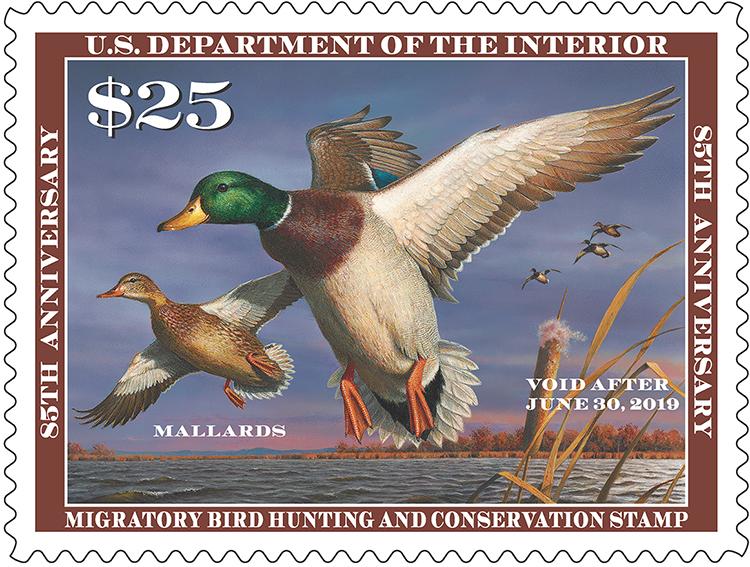 The following information is pulled from U.S. Fish & Wildlife Service and Friends of the Stamp.
The following information is pulled from U.S. Fish & Wildlife Service and Friends of the Stamp.
Also known as the Migratory Bird Hunting and Conservation Stamp, the Duck Stamp was conceived in 1934, when Congress passed and President Franklin D. Roosevelt signed the Migratory Bird Hunting Stamp Act (later amended to the Migratory Bird Hunting and Conservation Act). The first Duck Stamp was designed by J.N. "Ding" Darling, then director of the Bureau of Biological Survey (forerunner to today's U.S. Fish & Wildlife Service).
In addition to being the only conservation revenue stamp, the Federal Duck Stamp is also unique in the way the stamp is created. Each year, the U.S. Fish & Wildlife Service holds an art contest, the only juried art competition sponsored by the federal government. Any artist 18 years or older may enter, and the winning artist sees his or her work featured as the design on the following year's Federal Duck Stamp.
One of the easiest ways that anyone can support bird habitat conservation is by buying Federal Duck Stamps - among the most successful conservation tools ever created to protect habitat for birds and other wildlife.
Federal Duck Stamps are conservation revenue stamps; 98 percent of the purchase price goes directly to help acquire and protect wetland habitat and purchase conservation easements for the National Wildlife Refuge System. Wetlands acquired with Duck Stamp dollars help purify water, aid in flood control, reduce soil erosion and sedimentation, and enhance outdoor recreation opportunities.
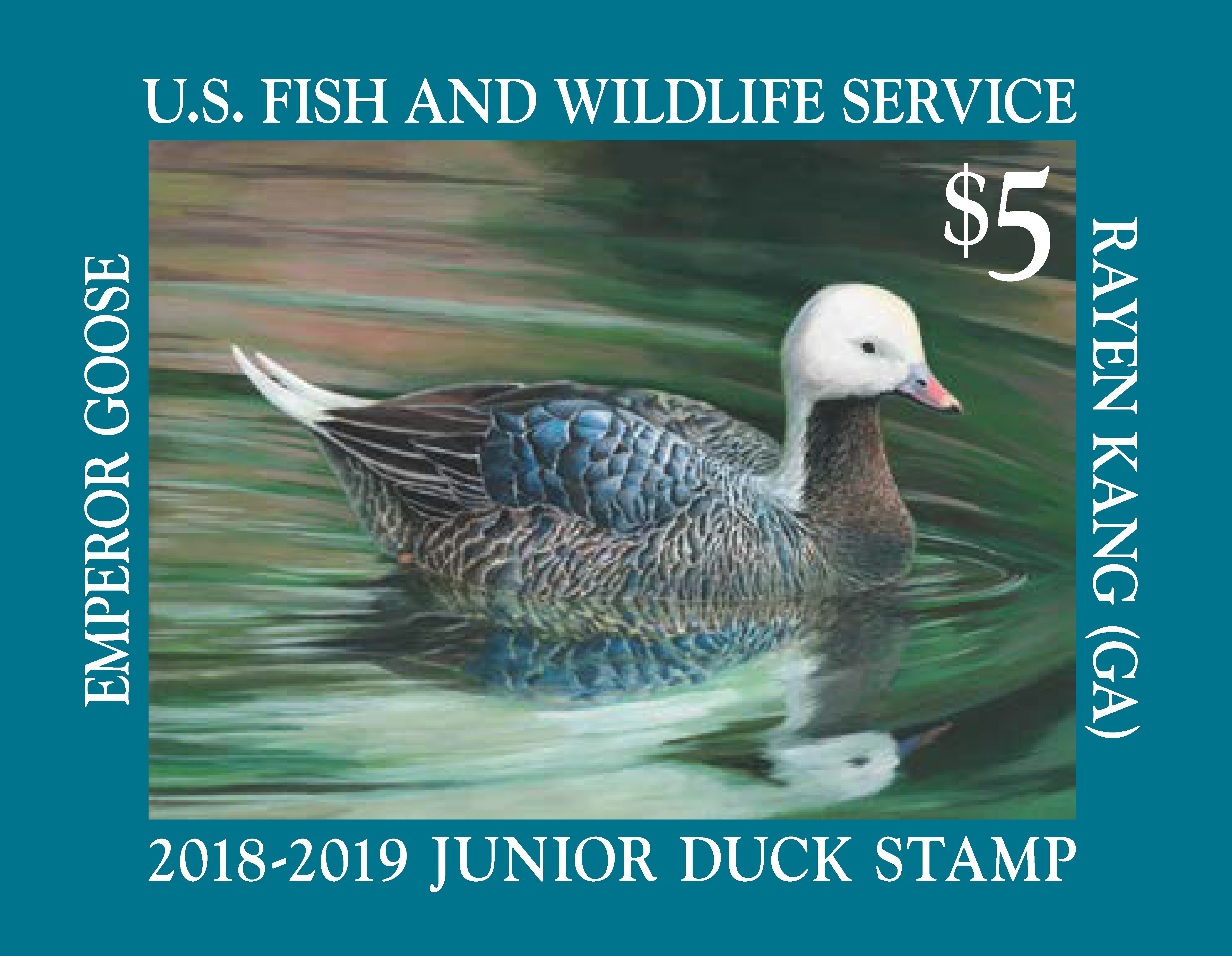
Your $25 purchase of a Migratory Bird Hunting and Conservation Stamp provides long-term benefits for birds and other wildlife and for the people who enjoy them. Since 1934, the stamps have secured over 5.5 million acres of wildlife habitat for the National Wildlife Refuge System. If you want to ensure future generations a heritage of enlightened conservation, the purchase of a stamp this year – and every year – is the best investment you can make. The stamps are beautiful, and they are essential to the lives of game and non-game species alike.
Some of the most diverse and wildlife-rich refuges in the nation have been acquired with Stamp funds. For example, see the following list of refuges and the percentage paid for through Stamp purchases.
| Chase Lake in North Dakota | 100.0% |
| Baskett Slough in Oregon | 100.0% |
| Sacramento in California | 99.6% |
| Bosque del Apache in New Mexico | 99.2% |
| Pea Island in North Carolina | 99.2% |
| Quivira in Kansas | 99.1% |
| Muscatatuck in Indiana | 98.9% |
| Horicon in Wisconsin | 98.7% |
| Monomoy in Massachusetts | 97.8% |
| Parker River in Massachusetts | 97.7% |
| Bombay Hook in Delaware | 95.2% |
| Santa Ana in Texas | 94.9% |
| DeSoto in Iowa and Nebraska | 90.8% |
| Anahuac in Texas | 87.3% |
| Montezuma in New York | 86.7% |
| Okefenokee in Georgia | 86.2% |
| Laguna Atascosa in Texas | 86.1% |
| Ottawa in Ohio | 86.0% |
| Edwin B. Forsythe (Brigantine) in New Jersey | 84.4% |
| Blackwater in Maryland | 73.0% |
| Chincoteague in Virginia | 69.9% |
And if that isn’t enough incentive, consider that 99.8% of all WPAs in Minnesota, Iowa, North Dakota, South Dakota, and Montana were acquired through Stamp funding. Or check out Cornell's eight great reasons to love the migratory bird stamp.
The Stamp is your annual "free pass" to visit any of the country's refuges that collect user fees—quite a bargain at $25! It's collectible art that fits in your pocket. Even better, you can slip the Stamp into a transparent plastic holder, clip it onto your gear, and show everyone that you support conservation and preserving our natural bequest to future generations. Stamps are available from the Postal Service, at select post offices and NWR offices, from Amplex Corporation, and at many large hunting and sporting goods retailers. The Stamp may not be valid for postage, but when it comes to habitat preservation, it's ever so valuable. Go and get your Stamp!
Also, check out Duck Stamps and the Best National Wildlife Refuges for Birding.
Illegal Trafficking of Birds
by Linda Slobodnyak
After reading The Feather Thief by Kirk Wallace Johnson and then reading the feature article in the Audubon Magazine Spring 2019 issue, I started thinking about how human beings across racial and cultural backgrounds seem to have an almost primal urge to possess and or profit in some way through owning live animals or their body parts. Birds are especially vulnerable to this human urge. While I have come across a few articles in ornithological magazines on this subject, I feel this grave problem doesn’t get as much coverage as it deserves. In my article I will be discussing a few of the bizarre cases and issues relating to the illegal bird trafficking trade.
The illegal trafficking of birds is big business. According to the World Wildlife Federation, it is valued at 19 billion dollars and is the fourth largest global illicit trade behind drugs, human trafficking and counterfeit products. Songbirds are especially vulnerable because of their small size, which makes them easy to smuggle. They are also desired for their beauty and their lilting songs. Much of the illegal songbird trade in the United States is located in Florida because of this state’s proximity to Latin America and the Caribbean.
In the feature article of the Fall 2018 issue of Audubon magazine I learned about a man whose name is Juan Carlos Rodriguez. Rodriguez was caught selling more than 180 birds to undercover wildlife agents for over four years, totaling $11,000. At this same time Fish and Wildlife Service agents were uncovering additional subjects selling a total of 40 protected migratory bird species including blue grosbeaks, painted buntings, and bobolinks. Rodriguez was among six defendants nabbed by Operation Ornery Bird.
We know people profit from the illegal sale of birds, but who is buying them? Well, just about anyone who claims to love birds. In the same Fall 2018 Audubon issue there is the case of coffee heir Jose Souto. He was caught by Fish and Wildlife Service agents of possessing 34 migratory birds on his estate. Souto’s lawyer told the press his client is just a bird lover. Souto’s punishment for violating the Migratory Bird Treaty Act was a $15,000 dollar fine, 1 month of probation, and to pay a $7,500 donation to The Tropical Audubon Society. According to the article this man got the maximum criminal fine. I don’t know about you, but to me this just doesn’t seem like justice. 80% of trafficked birds die before they are sold, and the ones who live and are part of some person’s collection will never breed again. The massive harm that this illegal trade is doing to bird populations, especially when habitat destruction and climate change are already driving migratory bird population numbers down, cannot be overstated.
The next story comes from the Cornell Lab of Ornithology Living Bird Magazine Winter 2019 issue. The Helmeted Hornbill is a magnificent bird that lives in the rainforests of Southeast Asia. The strange but beautiful helmet-like casque of this bird is coveted for its ivory-like qualities. That solid casque makes this bird a huge target for poachers. This has led the International Union for Conservation of Nature to make an emergency declaration elevating the Helmeted Hornbills status to critically endangered. The Helmeted Hornbill already has a limited habitat range. They are only found on the islands of Borneo and Sumatra, and up the Malay peninsula into Southern Thailand. In this range, they only live in intact old-growth rainforests where the trees grow large enough to support their nests. The reason why these birds are being killed is because there is such a high demand for the casques to be made into jewelry and carvings that are sold illegally in China. If this trend continues, it won’t be long before this unique bird is gone from the earth forever.
In Kirk Wallace Johnson’s book, The Feather Thief, the author explores the bizarre case of Edwin Rist, an American student in London, who in June of 2009 stole 299 bird skins from The Tring British Museum of Natural History. Rist’s main obsession in his life was the art of Victorian salmon fly tying. Many of the people who practice this hobby around the world have a desire to tie their flies with feathers of exotic and rare birds. For many sustainably sourced or dyed feathers just won’t do. Birds that were stolen from that rare collection included The Greater Bird of Paradise, the Spangled Continga, and the Resplendent Quetzal. These birds and their feathers are worth huge amounts of money on the black market.
Rist’s motivation for this crime was partly greed but he was driven by a desire to possess something rare, something from a bygone era when these birds were abundant. The upper and middle classes of the Victorian Era were caught up in a frenzy to collect birds, bird eggs, and their nests. It was seen as fashionable to collect nature and display it in one’s home or to even wear whole dead birds on hats. Edwin Rist caught that same lust from the past, and broke the law to live it out in the present. Rist never served a day in jail for his crime.
People may think this wasn’t a horrible crime deserving of severe punishment, because after all the birds are already dead. First things first, out of the 299 stolen skins only 102 intact skins with their labels still attached were recovered, 72 more had been seized from Rist’s apartment without labels and another 19 skins missing their tags had been mailed to the museum by the customers who bought them illegally from Rist. That means 106 birds were still missing. The scientific value of these skins is priceless, because many were collected by Russel Alfred Wallace and Charles Darwin, who drew upon them to formulate their theory of evolution. The discoveries made by the testing of these bird samples has given us scientific knowledge that is invaluable. Many skins that were recovered were deemed scientifically useless. Edwin Rist’s crime was not just against the Tring British Museum of Natural History but against scientific knowledge and understanding.
The 2019 Spring issue of Audubon magazine feature article explores the thorny problem of protecting Bald and Golden Eagles from slaughter and illegal trade of their feathers and the religious rights of Native Americans. Native Americans have long thought that Eagles were sacred and that their feathers carried prayers up to the heavens. To give Native Americans a legal way to bypass the 1918 Migratory Bird Treaty Act and the 1940 Bald Eagle Protection Act (amended in 1962 to protect Golden Eagles) the government established the National Eagle Repository, which is located in Denver, Colorado.
Federal agents were ordered to send all dead and injured eagles there. Members of a Federally recognized tribe can apply for 1 eagle or the equivalent of parts. Nice idea, but the repository couldn’t keep up with the demand of 573 Federally recognized tribes. This demand, which is mainly fueled by the pow wow and the Native American church, which are relatively modern inventions. The pow wow has evolved over the past half century into a collective of Native American identity. These pow wows are social events, tourist attractions, but they are mainly about prestige and money. There are $10,000 purses for costumes with the most eagle feathers at many of these pow wows. The more eagle feathers, the greater the chance of winning the big prize. When demand is high and supply is low, that creates black markets. Most Native American Courts only hand out slaps on the wrists for violators and Federal agents are reluctant to punish poachers sighting reasons of religious freedom. By creating a repository, the Federal Government has done it’s best to try to balance these opposing issues, protecting eagles and the religious expression of Native Americans, but the price of trying to recreate the past when there more people and fewer and fewer birds to satisfy that cultural longing is just too high.
No human culture on earth can recreate the past; there is just too much at stake. The protection of the priceless and beautiful birds that are left on this planet should bypass human desires. We need to do more to redirect this human longing to possess birds and the wild in general. Most human beings are inspired by the beauty and grace of nature, but we must do more to educate people in the harms of illegal possession, killing and trafficking of birds. All bird lovers must demand that our lawmakers take this problem seriously and dole out severe punishment to those who disregard and break our laws that protect all birds.